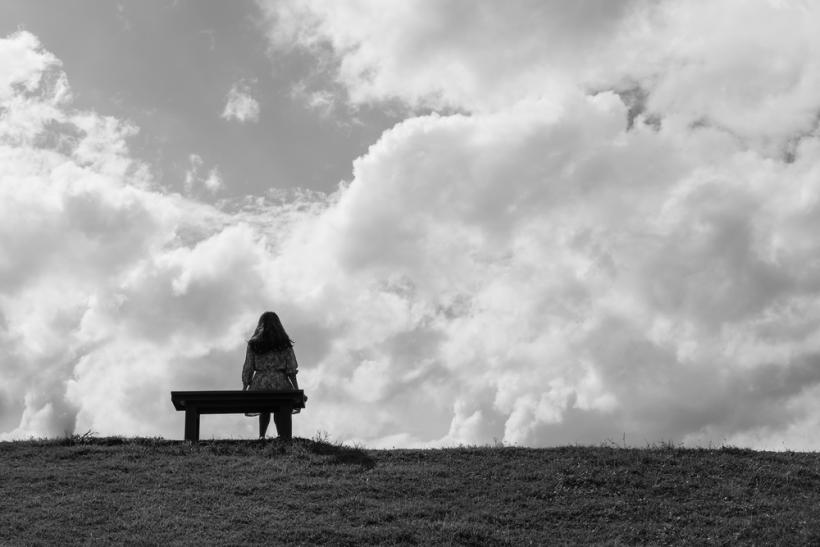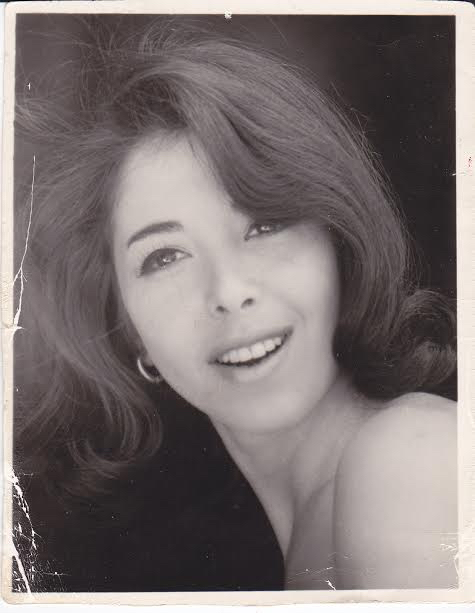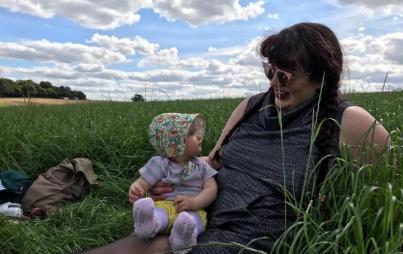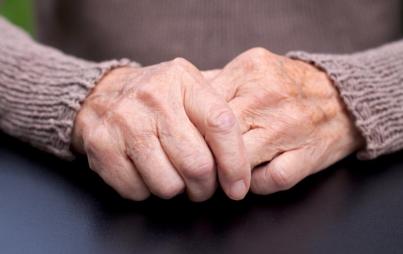
Daughters are experts on their mothers; my sister and I see precisely what is changed — so changed — in my mother’s face.
Recently I posted a photo of my mother — who is seventy-eight — on Facebook. In it she sits on a park bench, her arms extended in a joyous second position, one leg extended in front of her, her hip rotated outward and her sneakered foot pointing skyward. In the photo, she is all dancer. Her hair is a silky reddish brown — I make sure her silver roots are routinely coated with dye — and from a safe distance, you see a young face, an impish expression, a happy-go-lucky grin topping off the showy position of her body.
My friend Sandrine left this comment beneath the photo:
“Embrasse Ellie pour moi...29 ans et elle a si peu change.” (“Hug Ellie for me...29 years and she has changed so little.”)
We met Sandrine when she’d arrived from Paris as an exchange student when I was 12 and my sister 17; she had spent a summer at our apartment in Los Angeles. My mother must have seemed impossibly glamorous back then — a former Broadway dancer, a television actress in the 1960s, appearing on I Spy and Bewitched and Days of Our Lives. She taught a theatre dance class at Lichine Ballet Academy — haven to former movie stars and retired ballet dancers and the offspring of both; Sidney Poitier’s two daughters took her class. My mother arranged for Sandrine to visit the set of Santa Barbara — a soap opera more beloved in Paris than in the States, through a Hollywood producer friend. She put on old Woody Allen movies — another French obsession — and explained to Sandrine all the references.
“She has changed so little…”
Daughters are experts on their mothers; my sister and I see precisely what is changed — so changed — in my mother’s face.
We know what to look for, and we know what we will no longer find there.
It’s in the eyes. It’s what is not in the eyes, to be precise. A decade ago my mother’s brain spontaneously hemorrhaged. Up until this bleed, my mother’s crispness of mind was evident in the fierceness of her movements, the sharp blade of her sarcasm, the brightness of her eyes. That acuteness of gaze, that keen expression, has vanished. A blandness has replaced it. It’s as though a hurricane has swept through her cortex, the candle in her front window is blown out.
If you look very closely at her clothing in the photo — you can see what is different there, too. My mother’s clothes no longer make sense — she wears sweatpants and several layers of t-shirt and tank top and cardigan — because she has difficulty ordering how clothing is to be put on. She also has trouble with seasons. She has no memory of what month it is and no ability to reason by looking at the people passing below the window of her assisted living residence. (If they are wearing sweaters and carrying umbrellas, it must be cool but not freezing, it must be autumn and not winter, or spring and not summer…) She cannot perform basic problem solving or recognize context.
I look at the photo and see a damaged negative, a faulty blueprint.
It is not my mother.
My real mother did not wear sweatpants. My mother did not wear sneakers. My mother did not wear a tank top, and she certainly didn’t wear it over an old t-shirt. My mother did not wear white tube socks.
This is not a photo of my mother; it is a photo of dementia.
My mother had a date for the ballet a few months after her stroke. Jimmy, who had once been her boyfriend, had remained a loyal companion; he was taking her to see Swan Lake at American Ballet Theatre. Before her stroke, he used to wait for my mother in the lobby of her East Side apartment building when they had a date, mesmerized when the elevator doors swung open to reveal my mother, resplendent in evening dresses and heels, wearing the diamond brooch her mother-in-law had given her years ago, a cloud of delicate Bal à Versailles perfume trailing in her wake.
Jimmy met my mother at the Senior Center near her apartment; it was 2005, and at sixty-five years old she wanted to begin again, to figure out what exactly the Internet was. She was not unaccomplished; aside from her acting and dancing careers, she had turned to screenwriting when I’d entered high school, re-inventing herself after a divorce from my father. She set up shop with an ancient word processor, typing furiously before and after dinner time. She had sold our house and begun again after her divorce. Unhindered by romantic entanglement, my mother bloomed.
When I went to college in New York City, she sold her Los Angeles apartment, packed up and followed me there, moving into her mother’s apartment at the corner of 68th Street and Third Avenue, blocks from where she had attended grade school, and not far from where she had performed for years as a champion figure skater at Rockefeller Plaza.
As I came of age at Columbia University, my mother again re-invented herself, too. She attended computer training classes and met Jimmy. Whether my mother was a mother or a dancer or an actress or a screenwriter — or an “older woman” trying to learn Microsoft Excel — she was always dressed beautifully, trailing clouds of perfume, her hair bounced in shiny waves.
I think she sought in clothing what she lacked in life: order, precision, tailoring, the promise of the scent of perfume.
She made a kind of vow that she would not grow old; she would instead bypass middle age and refuse to retire from the throne of her own version of femininity.
My mother came of age in her sixties. She sued a man who had owed her money for years — my father, to be exact — and won. One night, she came home from a date to the ring of the telephone; it was my father calling from California. She held the phone patiently while he screamed at her. She removed an earring, slid off her stockings, and smiled at me reassuringly. She had to hold the phone protectively away from her ear at moments, but she kept smiling and gesturing to the phone: this, she seemed to say, is sometimes the work of women. Stand your ground, repeat your position, do not lose your footing by losing your temper.

She had grown confident later in life. She was so beautiful now, and somehow her wardrobe reflected that; she was a vision in costume pearls and peau de soie heels on the crosstown bus to Lincoln Center, Jimmy on her arm, himself resplendent in his topcoat and the affirmation of my mother’s companionship.
And then — the brain bleed. It was 2009, November had descended and the days were short. She put her head in her hands in the emergency room; so beset with pain that she could not even complain. She was sent into the vortex of triage; she was so quiet that the staff didn’t see the peril she was in. Within hours, three-quarters of her brain was soaked. She lay unconscious for days, and the doctors told us she would not wake up.
When she did wake up, surprising the team of doctors in the ICU, she mumbled incoherently and flew into feral episodes at sunset each night. And then she really woke up, and holding my sister’s and my hands in hers, she spoke in gentle tones. She was back, but we did not yet realize this came with a major caveat.
“Is Jimmy coming? Do you have a hairbrush and some lipstick? A decent blouse I could wear?"
We brushed and combed and coiffed, and damn it if my mother didn’t make the ICU a place of glamour, a throne from which she held court. And Jimmy did come, in his cashmere overcoat, holding flowers, standing nervously above her bed, as shocked as the rest of us that my mother spoke so well, moved with such grace, despite the mounting hemorrhagic pressure on her brain.
Only a few months later, whatever region of the brain that controlled her sense of who she was innately, that mysterious island comprising her manners, her warmth, her self-assurance, her crisp and fresh eye for clothes had been blown off the map of her personhood.
But the considerable damage had been done. We knew soon enough that she had lost her short-term memory. She had lost object recognition — she confused a spoon with a lemon, she could not find her way to the bathroom, she could not write her own name on a pad. The first month required exquisite patience and juggling of a thousand conflicting needs; we passed my mother back and forth, we took her for walks, we wept from exhaustion and grief. She did improve enough to leave the hospital, and for a time we tried to engage her in life as we moved her into assisted living.
A few months after the stroke, I met Jimmy and my mother at a Banana Republic near Lincoln Center. They had ballet tickets, and when Jimmy told me my mother was in sweatpants and sneakers — he had picked her up from her assisted living facility without my usual pre-date sartorial ministrations — I flew into a panic. Not my mother. The mythology of my youth might collapse entirely if I let my mother go to the ballet — to Lincoln Center and up that grand staircase lit by dazzling chandeliers and overlooked by Chagalls — in sweatpants.
She had shrunken in these months; she had lost weight and posture and carriage. She had also lost her clothes — underpants and trousers and blouses all went missing. I labeled her drawers methodically and repeatedly; it was hopeless. She was wearing sweatpants because she had little else to wear.
More than the sweatpants, what pierced me was her indifference to her appearance.
I tugged her into stockings, I put down my credit card for shiny high heels I could ill afford, I forced her into a simple wrap dress — black, my mother’s favorite —and a silky scarf to finish the look. I brushed her hair, willing her to care about how she looked. But since the moments when she had first awakened in the ICU —still caring about her appearance, her pride, her dignity, and glamour — she had deteriorated. Only a few months later, whatever region of the brain that controlled her sense of who she was innately, that mysterious island comprising her manners, her warmth, her self-assurance, her crisp and fresh eye for clothes had been blown off the map of her personhood. My mother was no longer — it was during that outing to the Banana Republic on Broadway, just a few blocks from what my mother once called “the heartbeat of New York City,” Lincoln Center, that I saw a woman other than my mother staring back at me — and at herself, dimly, in the mirror.
Jimmy begged me to relent. He saw that my mother was weary. In the dressing room, my mother smiled at me wanly — her weak acceptance of her daughter as boss was further proof that she was now unrelated to the woman who had raised me, who had been so certain in all matters sartorial. The sorrow spread thickly through my blood. I gave in. She wore the heels that night, but she ditched the stockings at some point, leaving them in her plush velvet theatre seat.
You Might Also Like: Looking Like My Mother Is The Closest I'll Ever Be To Her
After that night, I stopped dressing her for dates and outings. I wrapped the cord tightly around her curling iron and placed it in a box with her other things. There was a pearl ring a suitor had once sent her, a heart-shaped locket she had worn as a child (the gold chewed to bits by her baby teeth), and a charm bracelet from her youth which held among its treasures a tiny pair of figure skates, some ballet shoes, a piano, a college diploma, and the theatrical comedy and tragedy masks. All these represented her years of achievement, her glory, her sheen. Comedy and tragedy indeed.
It is now eight years after her stroke — she is 77. My older sister snapped a shot of her on a park bench after meeting with a neurologist, and this was the photo I posted. The doctor prescribed Gabapentin that day to ease my mother’s evening panic; he marveled nonetheless at how she had survived this stroke at all. Her very sitting up and breathing was a rebuke of the cat-scan that showed a brain blanketed in blood.
You don’t know my mother. I have wanted to say this to the neurologist every time we see him.
My mother is St. John Knits and L’eggs stockings and shiny barrettes adorning her silky bob. My mother is banging out a screenplay at an old computer on Gregory Way. My mother is racing past the fountain at Lincoln Center to make the eight o’clock curtain. You don’t know my mother.
Still, there she is posing for that photo that caused such a stir among my friends on Facebook. Their comments applauded her triumph.
Your mother — she is the same as when I met her when we were kids!
Once a dancer, always a dancer!
She is gorgeous!
Still performing! Look at that leg!
I look for my mother in the Facebook photo — her arms outstretched, smiling. Instead, I see the dim eyes, the confusion, the weariness. I see the torn joggers, the arms once well defined by dance have finally begun to soften, her once iron straight posture has at last succumbed to a slight curve. It is not natural aging; it is the cruel trick of a brain hemorrhage.
The other day I took my mother to lunch. I reminded her that she didn’t need a fork to eat a sandwich. I showed her three times where her bottle of juice was. I noticed how badly her Aerosole sneakers needed to be replaced. She did not.
“Mom,” I said, “I put a photo of you up on Facebook the other day.”
She smiled, covering her confusion.
“‘Hug Ellie for me.' That’s what Sandrine wrote under the photo, Mom.”
“I always hated diminutives,” my mother replied. I hated the name 'Ellie.' I always wanted to be called by my full name. Do you know what my full name is?”
Yes, Mom.
Whether in my dreams, where she wears her Adolpho cocktail dresses and her diamond brooch, or in real life, where she sits in her shabby joggers and torn sneakers on a park bench outside a neurologist’s office in downtown Manhattan — because she finds it more dignified, more regal, more her, my mother shall now be known as Eleanor — always.








